#sahagún
Explore tagged Tumblr posts
Text
You mean to tell me that after going on and off about Shrike's gun possibly being Xiuhcoatl for months I find a translation of the Florentine Codex where it says Huitzilopochtli also had a "turquoise spear thrower"?

#MAN.#gonna be looking for direct sources because it's not the first time I have found possible inspo from specific words/phrases in codices#like Scritch ��not speaking”#if nobody got me i know bernadino de sahagún got me#donkey stench#five sun theory#toasted texts
16 notes
·
View notes
Text
I had an idea!!
Aztec God Prince of the flowers Xochipilli ! Xie Lian
Aztec God King of the underworld and the dead Mictlantecuhtli ! Hua Cheng.
Listen LISTEN
Xochipilli ! Xie Lian makes sense because: he is a Prince, he doesn't request blood sacrifices. His offerings must be flowers, corn, and drinks. Oh, he is red-coded. Oh, and he embodies feminity and masculinity.
Mictlantecuhtli ! Hua Cheng makes sense because: he is the god King of the dead, he is playful can be a menace. The offerings and sacrifices must be jewellery, or birds, he isn't fond of blood, at least not from his own men.
*
There are challenges a soul has to endure to reach the Mictlán (paradise, the equivalent of Valhalla) Imagine someone (Jun Wu) throws Xie Lian there, without the tools to cross it. Hua Cheng would love to have some fun and obliterate the god who is lost in his territory, but he wasn't expecting a kind god, a beautiful one who made the barren land bloom, someone who helps the lost souls, and someone who indirectly shows that he isn't afraid of lord of the death.
Thank you.
#Will write this and create a collection of danmei x aztec mythology#Something small#it's time to show off the effort I put on reading Fray Bernardino de Sahagún; you all; it's difficult to read ancient Spanish#personal ramblings
14 notes
·
View notes
Text
For Butterfly Education & Awareness Day:
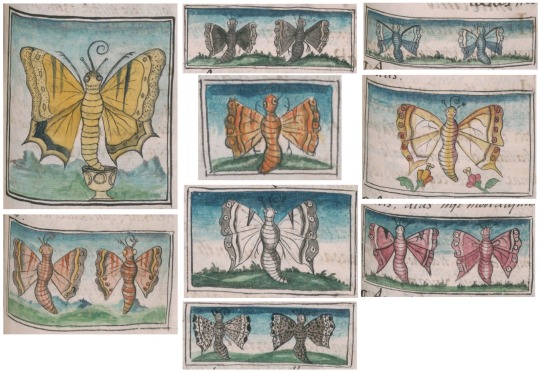
Composite image collecting the illustrations of papalotl (butterflies) in Book 11 of the Florentine Codex ("Earthly Things," the volume dedicated primarily to Aztec natural history). All illustrations were done by Indigenous Nahua artists; the 12-volume encyclopedia was compiled by Spanish Franciscan friar Bernardino de Sahagún and completed c. 1577.
See in the images embedded in the original text here: https://www.loc.gov/resource/gdcwdl.wdl_10622/?sp=6&st=gallery
#animals in art#indigenous art#Mesoamerican art#Florentine Codex#colonial art#16th century art#illustration#codex#illuminated manuscript#book art#butterfly#butterflies#insects#natural history art#Aztec art#Nahua art#Bernardino de Sahagún#Butterfly Education and Awareness Day#Butterfly Day#animal holiday
64 notes
·
View notes
Text
Leonora Carrington y la cocina alquímica
Leonora Carrington y la cocina alquímica #aperturaintelectual #palabrasbajollave @tmoralesgarcia1 Thelma Morales García

View On WordPress
#AperturaIntelectual#palabrasbajollaveAI#Arte#Benjamín Péret#Cultura#Emérico Weisz#Fray Bernardino de Sahagún#Hazelwood toffe#Leonora Carrington#Leonora Carrington y la cocina alquímica#Lucio Herbert#María Antonia Rosas#Mercados y tianguis#Molcajete#Mole#Personajes#Poesía#Remedios Varo#Thelma Morales García
2 notes
·
View notes
Text
DÍAS DE GUARDAR Domingo 5 de mayo de 2024
Arte: Emilio Jiménez Ofensiva empresarial: dinero por encima de sustentabilidad Sheinbaum en municipios competitivos para Morena Colectivas feministas y de buscadoras en tiempo de campañas Continue reading DÍAS DE GUARDAR Domingo 5 de mayo de 2024

View On WordPress
#Agenda Feminista#Alejandro Arena Barroso#Canirac#City Center#Claudia Sheinbaum#Concanaco#Derechos Medioambientales#Elección 2024#Jun Pablo Delgado#Manuel Bribiesca Sahagún#Verde Aquelarre
0 notes
Text
Mexican Neobank albo Continues to Soar with $40 Million Series C
Mexican neobank albo has successfully secured $40 million in growth funding, with an eye on achieving profitability by 2024. The funding round was spearheaded by Morpheus Ventures, a United States-based firm, and saw substantial participation from previous investors, including Valar Ventures from the United States and Nazca Ventures from Mexico.
Site: https://www.axioscreditbank.com/blogs/mexican-neobank-albo-continues-to-soar-with-40-million-series-c

0 notes
Text

Sancho III
Artist: Jose Madrid Castelaro y Perea (Spanish, 1801-1873)
Date: c. 1851
Medium: OIl on canvas
Collection: Museo del Prado, Madrid, Spain
Sancho III of Castile
Sancho III (c. 1134 – 31 August 1158), called the Desired (el Deseado),[was King of Castile and Toledo for one year, from 1157 to 1158. He was the son of Alfonso VII of León and Castile and his wife Berengaria of Barcelona, and was succeeded by his son Alfonso VIII. His nickname was due to his position as the first child of his parents, born after eight years of childless marriage.
During his reign, the Order of Calatrava was founded. It was also in his reign that the Treaty of Sahagún in May 1158 was decided.
Painting Description
The king, in the representation imagined by the painter, is descending the steps on which the throne is located. He is dressed in a crimson-coloured overcoat, embroidered in gold, with a fur lining, and his left hand is resting on his sword. The neutral background is broken up by the presence of the curtain situated behind the throne that closes the composition. Deposited in the Congress of Deputies. Madrid.
#portrait#ancient king#king of castile#sancho iii#standing#full length#crimson colored overcot#gold enbroidery#fur lining#sword#curtain#throne#king of castile and toledo#oil on canvas#painting#oil painting#european art#spanish culture#spanish history#jose madrid castelero#spanish painter#museo del prado#19th century painting
14 notes
·
View notes
Text


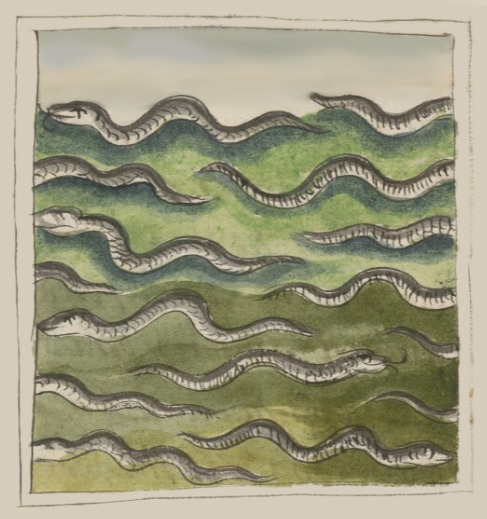
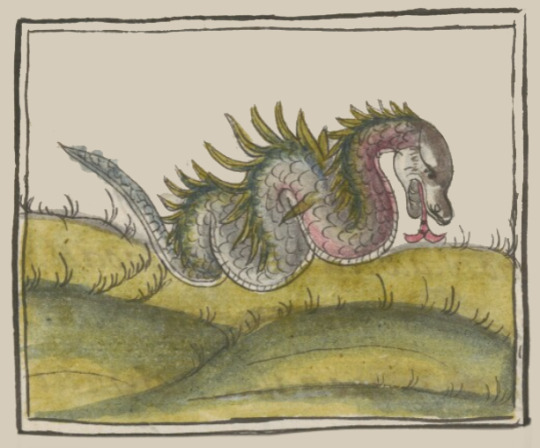
Tlahcuiloh (Nahua artist) - Zacatecoloti - Florentine Codex - Book 11 (Earthly Things) - folio 46v
Tlahcuiloh (Nahua artist) - Tecolotl - Florentine Codex - Book 11 (Earthly Things) -folio 46v
Tlahcuiloh (Nahua artist) - Break up of Coapetlatl - Florentine Codex - Book 11 (Earthly Things - Folio 84v
Tlahcuiloh (Nahua artist) - Quetzalcoatl - Florentine Codex-Book 11 (Earthly Things) - Folio 89v
The Florentine Codex is a singular manuscript created by Franciscan friar Bernardino de Sahagún and a group of Nahua elders, authors, and artists. Written in parallel columns of Nahuatl and Spanish texts and hand painted with nearly 2,500 images, the encyclopedic codex is widely regarded as the most reliable source of information about Mexica culture, the Aztec Empire, and the conquest of Mexico. Upon completion in 1577 at the Imperial Colegio de la Santa Cruz in Tlatelolco (today Mexico City), the manuscript was sent to Europe where it entered the Medici family’s library in Florence.
20 notes
·
View notes
Text

Xiuhtecuhtli, 2021.
"[...] Xiuhtecuhtli also has two other names, one is Ixcozauhqui, which means "yellow-faced"; and the other is Cuezaltzin, which means "flame of fire." He was also called Huehuetéotl, which means "The ancient god"; and they all had him for a father considering the effects that he did because he burns the flame, lights and embraces and these are effects that cause fear. Other effects have that cause love and reverence, as it is that he warms those who are cold and cooks the meats to eat, roasting and cooking and roasting and frying (Sahagún, 1956).[...]"
14 notes
·
View notes
Text

Bernardino de Sahagún
10 notes
·
View notes
Text
Kimitake Hiraoka was the sacrificed and the character he invented and lived in, Yukio Mishima, was the sacrificer. The moment the sword entered the belly, the two became one and the beheading is the sacrifice that was required by Bataille’s Acéphale.
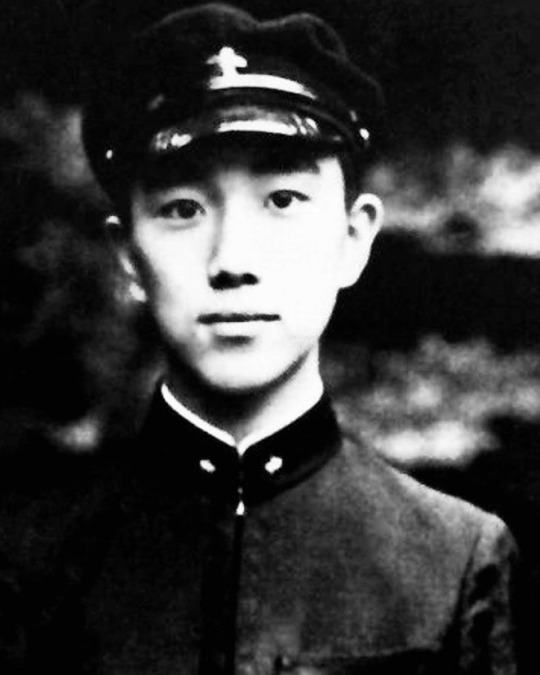

“The Victim, Sacred and Cursed
The victim is a surplus taken from the mass of useful wealth. And he can only be withdrawn from it in order to be consumed profitlessly, and therefore utterly destroyed. Once chosen, he is the accursed share, destined for violent consumption. But the curse tears him away from the order of things; it gives him a recognizable figure, which now radiates intimacy, anguish, the profundity of living beings.
Nothing is more striking than the attention that is lavished on him. Being a thing, he cannot truly be withdrawn from the real order, which binds him, unless destruction rids him of his "thinghood," eliminating his usefulness once and for all. As soon as he is consecrated and during the time between the consecration and death, he enters into the closeness of the sacrificers and participates in their consumptions: He is one of their own and in the festival in which he will perish, he sings, dances and enjoys all the pleasures with them. There is no more servility in him; he can even receive arms and fight. He is lost in the immense confusion of the festival. And that is precisely his undoing.
The victim will be the only one in fact to leave the real order entirely, for he alone is carried along to the end by the movement of the festival. The sacrificer is divine only with reservations. The future is heavily reserved in him; the future is the weight that he bears as a thing. The official theologians whose tradition Sahagún collected were well aware of this, for they placed the voluntary sacrifice of Nanauatzin above the others, praised warriors for being consumed by the gods, and gave divinity the meaning of consump-tion. We cannot know to what extent the victims of Mexico accepted their fate. It may be that in a sense certain of them "considered it an honor" to be offered to the gods. But their immolation was not voluntary. Moreover, it is clear that, from the time of Sahagún's informants, these death orgies were tolerated because they impressed foreigners. The Mexicans immolated children that were chosen from among their own. But severe penalties had to be decreed against those who walked away from their procession when they went up to the altars. Sacrifice comprises a mixture of anguish and frenzy. The frenzy is more powerful than the anguish, but only providing its effects are diverted to the exterior, onto a foreign prisoner. It suffices for the sacrificer to give up the wealth that the victim could have been for him.
This understandable lack of rigor does not, however, change the meaning of the ritual. The only valid excess was one that went beyond the bounds, and one whose consumption appeared worthy of the gods. This was the price men paid to escape their downfall and remove the weight introduced in them by the avarice and cold calculation of the real order.” - Georges Bataille, ‘The Accursed Share: An Essay on General Economy’ (1949) [p. 59 - 61]

#bataille#georges bataille#mishima#yukio mishima#sacrifice#accursed share#acephale#acéphale#tatenokai#general economy#general economics#aztecs
24 notes
·
View notes
Text

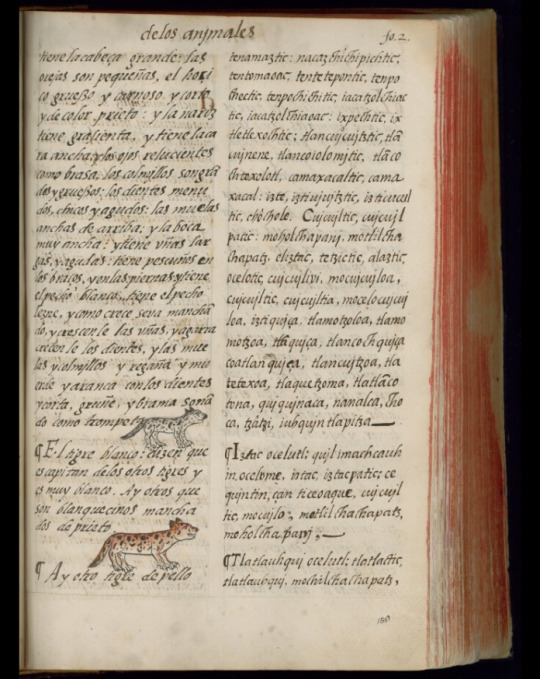
''The Digital Florentine Codex gives access to a singular manuscript created by Franciscan friar Bernardino de Sahagún and a group of Nahua elders, authors, and artists. Written in parallel columns of Nahuatl and Spanish texts and hand painted with nearly 2,500 images, the encyclopedic codex is widely regarded as the most reliable source of information about Mexica culture, the Aztec Empire, and the conquest of Mexico. Upon completion in 1577 at the Imperial Colegio de la Santa Cruz in Tlatelolco (today Mexico City), the manuscript was sent to Europe where it entered the Medici family’s library in Florence—thus, the Florentine Codex.''
''Libro undécimo, de las propriedades de los animales, aves, peces, árboles, yerbas, flores, metales y piedras, y de las colores
Capítulo I, de los animales Párrafo primero, de las bestias fieras
El tigre anda y vive en las sierras y entre las peñas y riscos, y también en el agua. Es noble, y dicen es príncipe y señor de los otros animales. Y es avisado y recatado, y regálase como el gato, y no consiente trabajo ninguno. Y tiene asco de ver cosas sucias y hediondas, y tiénese en mucho. Es baxo y corpulento, y tiene la cola larga, y las manos son gruesas y anchas, y tiene el pescuezo grueso. (...)''
© Getty Research Institute - Digital Florentine Codex
#book#mexico#history#florentine codex#art#drawing#nahuatl#spanish#español#digital resources#the getty museum
13 notes
·
View notes
Text



Reading List - Lista para Leer
Aves sin nido Clorinda Matto de Turner
Dom Casmurro Joaquim Maria Machado de Assis
Ariel José Enrique Rodó
El Moto Joaquin Garcia Monge
La amada inmóvil Amado Nervo
Desolación Gabriela Mistral
La señorita Etcétera Arqueles Vela
La vorágine José Eustasio Rivera
Doña Bárbara Rómulo Gallegos
Cuentos de Amor, de Locura y de Muerte Horacio Quiroga
Other selected works
Isabel Allende, “Dos palabras”
Anónimo, “Romance de la pérdida de Alhama”
Anónimo, Lazarillo de Tormes (Prólogo; Tratados 1, 2, 3, 7)
Gustavo Adolfo Bécquer, Rima LIII (“Volverán las oscuras golondrinas”)
Jorge Luis Borges, “Borges y yo”
Jorge Luis Borges, “El Sur”
Julia de Burgos, “A Julia de Burgos”
Miguel de Cervantes, Don Quijote (Primera parte, capítulos 1–5, 8 y 9; Segunda parte, capítulo 74)
Julio Cortázar, “La noche boca arriba”
Hernán Cortés, “Segunda carta de relación” (selecciones)
Sor Juana Inés de la Cruz, “Hombres necios que acusáis”
Rubén Darío, “A Roosevelt”
Don Juan Manuel, Conde Lucanor, Exemplo XXXV (“De lo que aconteció a un mozo que casó con una mujer muy fuerte y muy brava”)
Osvaldo Dragún, El hombre que se convirtió en perro
Carlos Fuentes, “Chac Mool”
Federico García Lorca, La casa de Bernarda Alba
Federico García Lorca, “Prendimiento de Antoñito el Camborio en el camino de Sevilla”
Gabriel García Márquez, “El ahogado más hermoso del mundo”
Gabriel García Márquez, “La siesta del martes”
Garcilaso de la Vega, Soneto XXIII (“En tanto que de rosa y azucena”)
Luis de Góngora, Soneto CLXVI (“Mientras por competir con tu cabello”)
Nicolás Guillén, “Balada de los dos abuelos”
José María Heredia, “En una tempestad”
Miguel León-Portilla, Visión de los vencidos (dos secciones: “Los presagios, según los informantes de Sahagún” y “Se ha perdido el pueblo mexica”)
Antonio Machado, “He andado muchos caminos”
José Martí, “Nuestra América”
Rosa Montero, “Como la vida misma”
Nancy Morejón, “Mujer negra”
Pablo Neruda, “Walking around”
Emilia Pardo Bazán, “Las medias rojas”
Francisco de Quevedo, Salmo XVII (“Miré los muros de la patria mía”)
Horacio Quiroga, “El hijo”
Tomás Rivera, . . . y no se lo tragó la tierra (dos capítulos: “... y no se lo tragó la tierra” y “La noche buena”)
Juan Rulfo, “No oyes ladrar los perros”
Alfonsina Storni, “Peso ancestral”
Tirso de Molina, El burlador de Sevilla y convidado de piedra
Sabine Ulibarrí, “Mi caballo mago”
Miguel de Unamuno, San Manuel Bueno, mártir

#lista para leer#catholic#feminine#reading list#Spanish reading list#spanish#reading#books to read#classic books
7 notes
·
View notes
Text
El patrimonio gastronómico
El patrimonio gastronómico #aperturaintelectual #palabrasbajollave @tmoralesgarcia1 Thelma Morales García
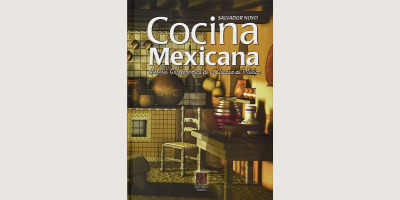
View On WordPress
#AperturaIntelectual#palabrasbajollaveAI#Arte#Cocina Mexicana. Historia Gastronómica de la ciudad de México#Comida casera mexicana#Comida Prehispánica#Cultura#Dieta del mexicano#Editorial Porrúa#Fray Bernardo de Sahagún#Gastronomía en México#Maíz#Mercados y tianguis#Patrimonio Gastronómico#Personajes#Poesía#Salvador Novo#Tecuil#Thelma Morales García#Tortilla#Xiuhtecuitli (Dios del fuego)
2 notes
·
View notes
Text
#Menchaca UNA REALIDAD LA REACTIVACIÓN ECONÓMICA DE CIUDAD SAHAGÚN
#Menchaca UNA REALIDAD LA REACTIVACIÓN ECONÓMICA DE CIUDAD SAHAGÚN

View On WordPress
0 notes
Text
I was tagged in this by @nikoteani so here you go!
Last song: No guilt by The Waitresses
Favorite color: Light purple or silver
Currently watching: I'm rewatching Julie and the Phantoms, and I'm watching Fantasy High Junior Year
Sweet/Savory/Spicy: Sweet most of the time
Relationship status: Single
Current Obsession: Fantasy High and Mythology (specifically Greek and Aztec)!
Last thing you searched: The Florentine Codex, which is a collection of research of Aztec religion from Bernardino de Sahagún
Tagging: I'm not really on Tumblr that much so I don't have anyone to tag, but if you want to feel free? I'm pretty sure no one will see this though.
3 notes
·
View notes